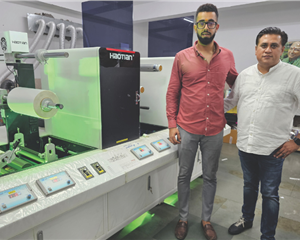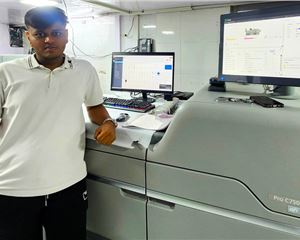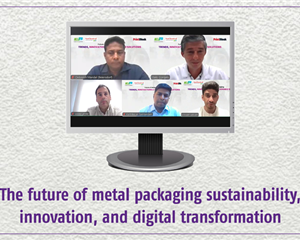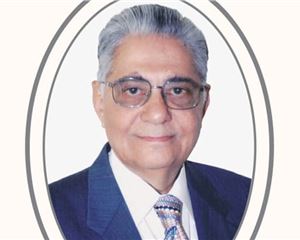“The market for offset and flexo gravure will witness a small but definite rise in business”
Inknews in conversation with Sambit Roy, who has rich experience of over 15 years in the field of colourant applications, business development, and sales and marketing at Clariant Chemicals.
25 Jun 2014 | By PrintWeek India
What are the products you produce for printing ink industry? Its application in other industry eg Paint or any coating industry?
Clariant is a leading producer of pigments for the entire printing application sector. It manufactures pigments, pigment preparations and additives for the printing ink industry and also offers a comprehensive range of process colours and spot coluors, along with long standing technical experience, quality consistency and supply reliability.
We not only produce pigments for publication inks such as publication gravure, coldset offset and heatset offset inks but also produce pigments for packaging inks such as gravure and flexographic inks. In addition, we also offer pigment preparations and dyes for these applications. Clariant also has an entire range of products for inkjet application. We specialise particularly in products for security inks and deco lamination. Many of these products are also used in other industries like paints and plastics because of their swiftness.
What new products have your company recently launched and what kind of inks do they produce?
At Clariant, we continuously strive to develop products as per our customer requirements. We cater to the entire printing industry offering solutions across segments. We recently launched some products for publication inks, packaging inks, inkjet Inks and toners segments. A recent addition to our existing line of products is Hostaprint pigment preparations for inkjet inks.
Are you seeing any difference/change in the buying pattern from the ink industry?
Today customers are increasingly looking for a balance between the price and performance of the products. They have become aware of the safety aspects of colourants and demand the same while purchasing these products. The industry is still using PR8 which has carcinogenic pigments and this needs to change.
Do you have a manufacturing plant in India?
At Clariant, we seek to constantly provide customers with high quality products specifically tailored to their needs. In line with this, we unveiled an upgraded technical service laboratory for pigments at our Cuddalore site (Tamil Nadu) and last year also proceeded with a 50% expansion in capacity at our Azo pigments and pigment preparations plants in Roha. These investments further enhance the capabilities and output at our respective sites in a sustainable manner by reducing energy consumption and expanding the range of low VOC-containing pigments preparations offered to the market.
What are the constraints of manufacturing/supplying raw materials?
I’ve listed three below.
• Many of the raw materials used for pigment manufacturing are imported; as a result most manufacturers are heavily impacted by the fluctuations in dollar prices. This also has an impact on the price of colourants they manufacture. At Clariant, we are aware that the printing ink segment is a highly price sensitive market, however, it is difficult as a raw material supplier to absorb the cost increase and it is often passed on to the end user.
• The product safety aspect in printing inks has also become important; this is visible from the increasing number of queries we receive for product safety issues. Several norms are to be followed during manufacturing which directly or indirectly increase the cost of the product.
• As printing ink is a highly price sensitive market, it is tough to get the price from manufacturers today, as they have to follow various norms and regulations laid by various government authorities. They have to adhere to the environmental norms described by the pollution control board.
Raw materials continue to be among the top cost pressures for small and mid-sized manufacturers, and the ability to manage these costs remains a top sourcing concern. How should the procuring company address this critical supply concern?
The cost pressure is faced by ink makers and by manufacturers too. Though we cannot escape the cost increase completely, we can reduce its impact by better planning our activities. Clariant believes in achieving operational excellence by striving for optimum efficiency across the sectors that empower sales and marketing to offer best customer service and value.
The print industry has been witnessing a change in the way print is being demanded. The structure of the traditional process (offset) which is associated with long-runs is being challenged by growing demand for short-runs, now fast getting recognised with digital printing. What do you make out of this development?
Over the last few years, there has been an increasing demand of smaller print runs which are normally satisfied by the inkjet technology. We believe that this trend will continue as the industry becomes more personalised. However, this does not mean that traditional processes such as offset and flexo gravure will decrease. In India particularly, we feel the market for offset and flexo gravure will witness a small but definite rise in the business in the next 4-5 years.
To keep pace with the changing market trends, Clariant also now offers Hostaprint pigment preparations and special products for copy charging and fine pigments for inkjet inks too.
Clariant already has world class, technology driven products for the new non-traditional printing segment and it is also continuously increasing its portfolio of new technology driven products. Hence, we are well prepared for any change that may come our way.
As supply chains become more complex and exposed to global risks, what’s the best approach to reduce the vulnerability of this operating environment?
Long term, careful planning of available resources, working closely with the value chain and a review of the economic and social environment at closed intervals help in reducing the vulnerability of the operating environment. Forecasting and maintaining lead time and ABC product analysis is also a must.
Has quality been sacrificed by specifying inferior, alternative materials or components? Are ink makers approaching product design in a different way?
Over the years the speed of the presses has increased considerably; the FMCG sector is also placing more and more product safety regulations in place. In such a situation, we do not feel that quality can be sacrificed by inferior, alternative materials or components. At the same time, over engineered products too cannot be adapted in such a cost competitive market. We believe that all ink makers as well as their raw material suppliers are working towards providing the right combination of cost and quality.
At Clariant, we also emphasise on satisfying customers’ needs without compromising the quality and safety requirements of our product and always manufacture as per environment, safety, health and administration (ESHA) guidelines.
What other factors, beyond price, should ink makers consider when choosing suppliers?
Consistent quality, supply, support with respect to product safety and effective technical service from raw material suppliers are the key factors.
Customers of printing ink manufacturer are looking for greener technologies, who in turn would demand raw material which will help them produce such products. How is your company meeting those needs?
At Clariant, we drive excellence and seek to create value for all our stakeholders. Being a global specialty chemicals company, we add value to our technologies and offer innovative, customised and superior quality products to our customers. We have several guidelines to ensure product and production safety that are intended to minimise the impact of our businesses on environment, safety, health and administration (ESHA). The most important goal of these activities is to protect environment against potential hazards. Every facility of Clariant across the world is required to adhere strictly to the principles of cleanliness and safety code outlined by the group’s ESHA guidelines. The safety and environment sustainability policies and procedures are also revised consistently keeping in mind the dynamic disposition of environment and safety issues.
Our pigments plant at Roha in Maharashtra also received the global ISO 22716 Cosmetics Good Manufacturing Practice (cGMP) certification. The accreditation further signifies our commitment to ensure dependable products, processes and service at the local level.
Use of green and safe technologies has always been a motto of Clariant’s business whether it operates out of India or any other country across the globe. We have a wide range of products which satisfy various statutory requirements. We would also like to mention here that in many cases our prescribed limits for the restricted substances are much below the limits prescribed by the law and hence we are confident of supporting our customers and meeting their demands of greener technologies.
We also have a range of products approved under US FDA; we have a detailed database wherein our products which can be offered under various legislations are mentioned. Printing and retort packaging require products with special migration resistant properties and Clariant has a whole range of products for this particular application.
In addition, the safety and environment sustainability policies and procedures are revised consistently keeping in mind the dynamic disposition of environment and safety issues.
China has managed to dislodge the global players in technology, volumes and economies. What has stopped Indian multinationals or the large Indian companies or otherwise from creating the same kind of scaling operations?
As you would know, the Indian specialty chemicals industry has displayed positive growth over the last few years. It is characterised by substantially lower penetration against a user base that sees increasing globalisation and higher disposable income. Besides these, the industry is also benefiting from macro-economic trends.
We will continue to focus on markets like India and China, ASEAN and Latin America with future prospects and strong growth rates and businesses that have a competitive position, resulting in strong pricing power. India is a very important market for Clariant and over the last year we have been making significant investments across our business units. In India, we are further focused on our core businesses like Masterbatches, to further improve our market presence wherever possible. In line with this, we recently acquired Plastichemix Industries, a pioneer in the Masterbatches business, based in Gujarat for Rs 135-cr. Another example is an additional investment of Rs 38-cr at our Pigments plant at Roha in Maharashtra. Through these investments, we plan to strengthen our presence in the market and aim to bring international standards that best suit Indian market needs.
Apart from this, China has also emerged as a manufacturing hub globally, whereas, India is viewed as the service provider of the world. If the chemicals industry needs to grow on the lines of China, conscious and determined efforts need to be made by all of the important local stakeholders, to better this situation.
What areas are your R&D efforts focusing on for the future?
As mentioned earlier, we see a bright future for the Masterbatches business in India and we are currently in the process of doubling our growth. We are set to establish highly advanced technology leading to the creation of a robust system across platforms; for eg: upgraded technical service lab to modernised manufacturing practices, leading to tailor-made products.
Our R&D efforts focus on supporting customers in emerging markets like India with high quality products that are sustainable and enhance customer experience. Last year, we invested Rs 38-crore in our pigments business at Roha and also commenced a new technical service lab at the Cuddalore site. Our core businesses also have very strong service labs across its segments, these aid in supporting the customer’s focused needs.
Would you like to highlight on any of your R&D initiatives?
In July 2013, we proceeded with an expansion capacity at pigment preparations plants in Roha, India, with a focus on providing customers in the region with high quality products specifically tailored to their needs. This investment further enhances the capabilities and output at the site in a sustainable manner by reducing energy consumption and expanding the range of low VOC-containing pigments preparations offered to the market.
These investments support the strong market growth in India and also mark another step in Clariant’s efforts to enhance its on-the-ground presence and offer more intimate customer service to customers in the emerging Indian and Asian markets. In addition, a new upgraded technical service laboratory for pigments also commenced operations at our Cuddalore plant (Tamil Nadu).
Do you have any further expansion plan?
With reference to our presence in inks particularly, we look forward to double our manufacturing capacity this year. Also as mentioned earlier, we see a bright future for the Masterbatches business in India and we are currently in the process of doubling our growth. We are further focused on our core businesses like Masterbatches, pigments and industrial and consumer specialties, to enhance our market presence across our businesses.
Clariant in India is on an accelerated market growth strategy with an equal focus on market growth segments. We intend to generate additional growth by continuing to undertake strategic initiatives and increase our focus on innovations. Recent investments will also support growth and increasing margins. The new Clariant is well prepared to become a leading specialty chemicals company that generates value through innovations and offers solutions rather than products. To complement our portfolio, Clariant will also seek more opportunities to broaden its base. We will create value at Clariant in the next few years that will benefit our employees and shareholders.
The article has been compiled by Noel D'cunha and was first published in Ink News












 See All
See All